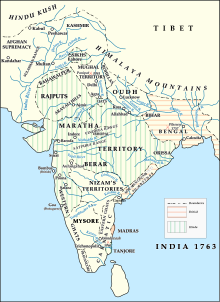Northern Circars
| Northern Circars | |||||||||||
|---|---|---|---|---|---|---|---|---|---|---|---|
British India | |||||||||||
| 1823–1947 | |||||||||||
|
Flag | |||||||||||
 The Northern Circars shortly after their occupation by the British | |||||||||||
| Capital | Eluru | ||||||||||
| Area | |||||||||||
| • Coordinates | 17°27′N 83°00′E / 17.45°N 83.00°E | ||||||||||
• | 78,000 km2 (30,000 sq mi) | ||||||||||
| • Type | British Colonial Government | ||||||||||
| Historical era | 20th century | ||||||||||
• The British buy the rights over the Circars | 1823 | ||||||||||
• Independence of India | 1947 | ||||||||||
| |||||||||||
| Today part of | |||||||||||
The Northern Circars (also spelt Sarkars) was a division of
They became British in a protracted piecemeal process lasting from 1758 to 1823, involving diplomacy and financial settlements rather than military conquest. The annexation by the British of the Northern Circars deprived
Etymology
Circar was an English spelling of
"Northern Circars" meant the northern districts of the Nizam's dominion.Eventually "Circar" also acquired the meaning of "British Sarkar", i.e., the British government.[6] Hence, "Sarkar districts" could also be understood as the districts under the administration of the British government. In British maps, the area might just be labelled "Circars".[7]
Geography
The Northern Circars were five in number: Chicacole (Srikakulam), Rajmandri (Rajahmundry), Ellore (Eluru), Mustaphanagar (Kondapalli) and Murtuzanagar (Guntur), with a total area, was about 30,000 square miles (78,000 km2)[1] when Nizam initially lost control of them to the European Colonizers.[8]
In the main, the region at various points of time corresponded to the northern and the central parts of
History
The region was invaded by the
In 1674, Vishwambhar Dev of
In 1724,

In 1765, Lord

The Northern Circars were governed as part of Madras Presidency until India's independence in 1947, after which the presidency became India's Madras State. The northern, Telugu-speaking portion of Madras state, including the Northern Circars, was detached in 1953 to form a new 'Andhra State'. The Andhra State was merged with the Telugu-speaking parts of Hyderabad State in 1956 to form a united Andhra Pradesh. The two were bifurcated again in 2014 as Andhra Pradesh and Telangana.
See also
- Rajamundry Sarkar
References
- ^ a b c d e f g One or more of the preceding sentences incorporates text from a publication now in the public domain: Chisholm, Hugh, ed. (1911). "Circar". Encyclopædia Britannica. Vol. 6 (11th ed.). Cambridge University Press. p. 380.
- ^ "Madras District Gazetteers, Volume 1". Superintendent, Government Press. 1915. p. 235.
- ^ P. N. Chopra, B.N. Puri & M.N. Das, A Comprehensive History of India, Volume 3. pg. 298
- ISBN 978-1-108-02828-8
- ISBN 978-81-7022-195-1
- ^ A Collection of Treaties, Engagements, and Sunnuds Relating to India and Neighbouring Countries: States in Rajpootana, Central India, and the mediatized chiefs in Central India and Malwa, Re-printed at the Foreign Office Press, 1876, pp. 538–
- ^ As in this map in a popular atlas of 1907, in fact showing "India in 1795".
- ^ Great Britain India Office. The Imperial Gazetteer of India. Oxford: Clarendon Press, 1908.
- ^ a b Senapati, N. (1966). "Orissa district gazetteers : Koraput". INDIAN CULTURE. pp. 66–69. Retrieved 3 June 2021.
- ^ Deo Kumar Bidyadhar Singh (1961). Nandapur A Forsaken Kingdom Part-i (Second ed.). p. 69.
- ^ The History of Vizag

